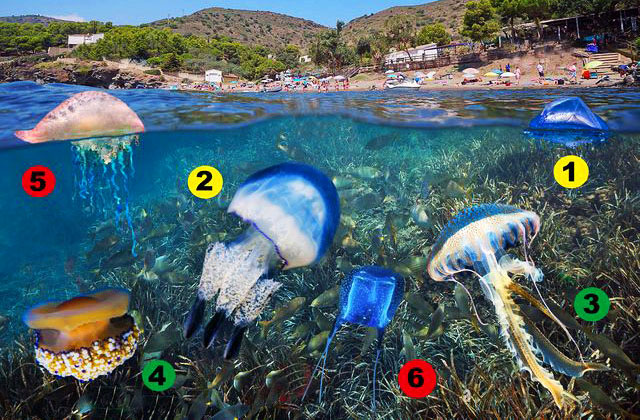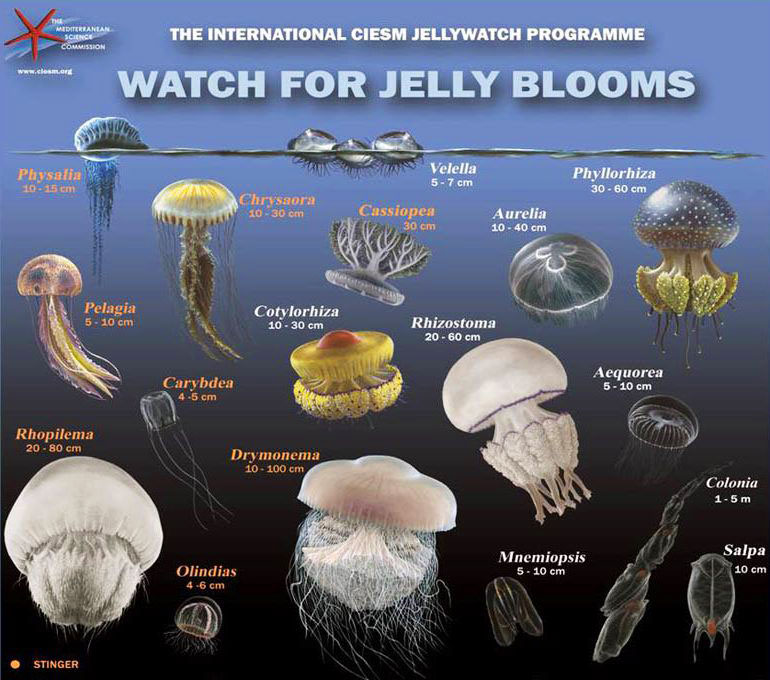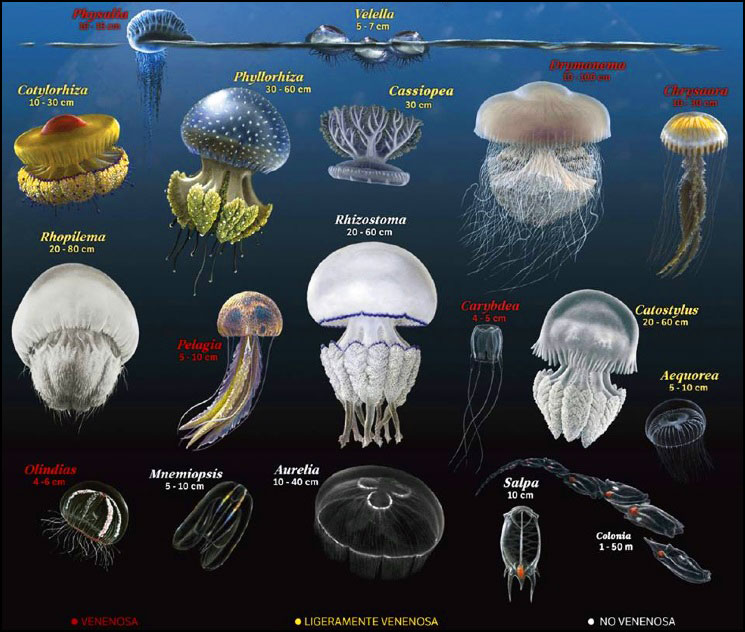These are the most common species in the Mediterranean:
1 – Velella velella, medusa velero.
2 – Rhizostoma pulmo, medusa aguamala.
3 – Chrysoara hysoscella, medusa acalefo.
4 – Cotylorhiza tuberculata, medusa huevo frito.
5 – Physalia physalis medusa carabela portuguesa.
6 – Carybdea marsupiales, medusa avispa de mar.
All stingers marked in red are the most dangerous, those marked in green are medium venom, and those marked in yellow are weak venom. In case you may get hives with some of them, the recommendations are clear, NEVER rub the affected area, apply ice, but not directly, wrapped in cloth, and wet the area with 50% baking soda solution and seawater.
The traditionally used antidote, dousing with ammonia, has proven counterproductive. If symptoms worsen, go to the emergency room.

Other dangerous jellyfish include the Irukandji Jellyfish, the Lion’s Mane Jellyfish, and the Portuguese Man-of-War. These jellyfish can cause severe pain, vomiting, respiratory problems, and even heart attack and death.

There are many different types of jellyfish, and some can be quite dangerous. The box jellyfish is one of the most venomous creatures on Earth and can cause death within minutes. Other dangerous jellyfish include the Portuguese Man-of-War, the lion’s mane jellyfish, and the Irukandji jellyfish.

Other dangerous jellyfish include the Portuguese Man-of-War, the stinging nettle, and the Irukandji Jellyfish. So if you’re ever swimming in the ocean and come into contact with a jellyfish, it’s best to get out of the water as quickly as possible and seek medical attention.

These jellyfish can also deliver a painful sting, but they are not usually fatal. However, they can still cause serious illness and even death in some cases. It is important to be aware of these dangerous Jellyfish species and to avoid them if possible.

There are dozens of types of jellyfish, and many of them are capable of delivering a painful sting. However, only a handful of jellyfish species are truly dangerous to humans. The most notorious of these is the box jellyfish, which is found in tropical waters around the world. Box jellyfish are relatively small, but their sting is incredibly powerful and can be fatal. Fortunately, there are only a handful of recorded fatalities from box jellyfish stings each year.
Other potentially dangerous jellyfish include the lion’s mane jellyfish (found in cold waters off the coast of North America and Europe), the Irukandji jellyfish (found in Australia), and the sea wasp (found in Indo-Pacific waters). These jellyfish can all deliver a painful sting, but they are not usually fatal. However, they can still cause serious illness and even death in some cases. It is important to be aware of these dangerous Jellyfish species and to avoid them if possible.
Other less dangerous types of jellyfish can still deliver a painful sting that can last for quite some time. So it’s always best to be cautious around any type of jellyfish, even if they don’t appear to be particularly harmful.
The most widely recognized type of hazardous jellyfish is the box jellyfish (Cubozoa). These carnivorous animals have tentacles covered with microscopic nematocysts which contain poison for paralyzing prey and inflicting great pain on anything that touches them. Different species produce various levels of venom but it is considered the most potent found among marine creatures. Box jellyfishes have been known to cause death by cardiac arrest when contacted by humans; however, fatalities from contact with this species are rare in areas where preventive measures and first aid treatments such as pressure immobilization bands has been taught.
Additionally, some of the other more commonly encountered hazardous jellies include Lion’s Mane Jellyfish (Cyaneidae), Sea Wasps/Bluebottles (Physalia) and Irukandji Jellyfishes (Carukia barnesi). Each type contains toxins that affect victims mentally as well as physically causing a range of adverse reactions including breathing difficulties, intense headaches, muscular pain and abdominal cramps just to name a few symptoms associated with contact with these critters’ stinging cells. Similar precautionary methods must be observed if people come into contact with these organisms such as rapid removal from water without touching their tentacles directly followed by rinsing affected area for 15 minutes using vinegar solution or meat tenderizer mixed in cold water before medical attention can be sought out if serious injury has occurred afterwards.
It is highly recommended for those who plan on swimming or walking through shallow waters containing any form of unknown aquatic life forms without proper protective clothing equipment – particularly during night hours -to take necessary safety measures beforehand since different types of jellies inhabit various regions around the world especially tropical areas near oceans, bays and riverbanks alike so caution should always be exercised before entering any kind of unfamiliar terrain underwater at all times due diligence must always prevail when encountering nature’s mysteries!
Please login or Register to submit your answer
